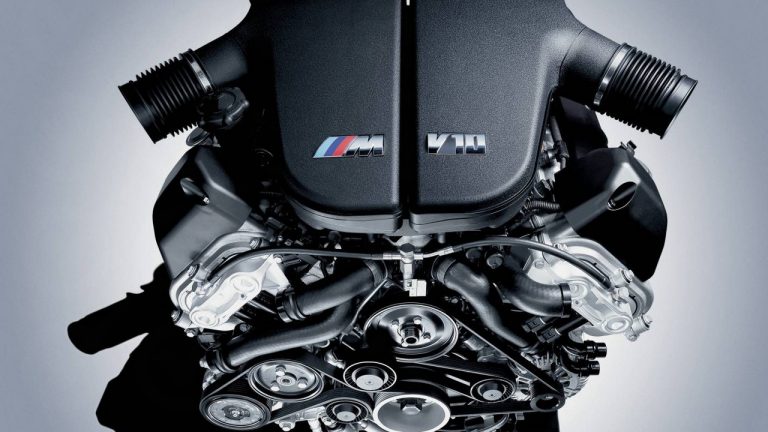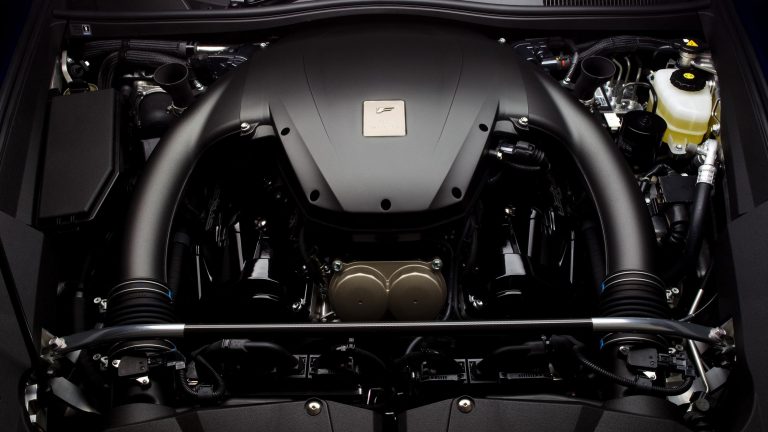[su_image_carousel source=”media: 9148,9149,9150,9151,9152,9153,9154,9155,9156,9157,9158,9159″]
Introduction
The BMW S85 engine was a 4999 cc V10 petrol engine – with a 90-degree ‘V’ – which had a 92.0 mm bore and a 75.2 mm stroke. According to BMW, the S85 engine was designed using knowledge gained from development of the BMW Sauber F1 P84/5 engine (a 3.0-litre V10).
Replacing the S62 engine, the S85 engine won the International Engine of the Year award in 2005 and 2006. The S85 engine was superseded by the S63 engine.
S85 block and crankcase
The S85 engine had a two-piece Alusil crankcase with a reinforcing bedplate. The bedplate was machined together with the crankcase and, when the engine was assembled, the bedplate was mounted to the upper section of the crankcase. Furthermore, the bedplate assembly contained cast iron bearing bridges to absorb additional forces from the pistons and connecting rods, and the engine serial number was stamped on the bedplate assembly.
The S85 engine had cross-flow cooling, though each cylinder had its own radiator feed and the coolant thermostat was located on the return flow line. The radiator had an upper and lower tank for the first and second cylinder banks, respectively.
Components and internals
The S85 engine had a forged steel crankshaft that was ‘nitro-carburized’ for increased surface hardness. Furthermore, the crankshaft had five crankpins, each offset 72 degrees apart. The forged steel connecting rods had a ‘cracked’ configuration on the ‘big end’ and, to reduce mass, the small end of the connecting rod had a trapezoidal shape and a tapered piston pin.
The S85 engine featured CNC machined ports and combustion chambers.
S85 cylinder head and valvetrain
The S85 engine had a one-piece, aluminium cylinder head and a cast aluminium cylinder head cover. The ‘hollow chill’ cast camshafts had BMW’s high-pressure double VANOS (variable intake and exhaust camshaft phasing) system which used a high pressure pump – driven directly from the crankshaft via a gear-to-gear connection – to provide pressure up to 115 bar.
Each intake camshaft had a single-roller timing chain, while the exhaust camshafts were driven by a gear-to-gear connection between the intake camshaft sprocket and the exhaust camshaft sprocket. The intake camshaft had 60 degrees of adjustment, while the exhaust camshaft could be adjusted up to 37 degrees.
The S85 engine had four valves per cylinder with hydraulic valve actuators (HVA) and ‘box type’ tappets. The one-piece intake valves were produced from a steel alloy (X45CrSi9-3), while the two-piece exhaust valves a steel alloy (X45CrSi9-3) stem that was friction-welded to the valve head (NiCr20TiAl alloy).
Although the S85 engine did not have dry-sump lubrication, two electrically oil pumps would commence operation when a transverse acceleration of 0.8 g was reached.
Intake and exhaust
Air supply to the engine was controlled by ten individual throttle valves (one per cylinder), which were actuated by two throttle motors (one per cylinder bank). Finally, the S85 engine had stainless steel, hydroformed exhaust manifolds; the exhaust tubes had a 5-into-1 design with one ‘near engine’ catalyst per cylinder bank.
Ignition
Inside the combustion chamber, there were aluminium alloy cast pistons and the S85 engine operated at a compression ratio of 12.0:1. Maximum engine speed for the S85 engine was 8250rpm and the cylinder firing order was as follows: 1, 6, 5, 10, 2, 7, 3, 8, 4 and 9.
The S85 engine had an ‘ionic current’ knock control mechanism in which engine misfires and knock could be measured simultaneously by passing a low voltage across the spark plugs immediately following the ignition spark.
[su_table responsive=”yes”]
| Engine | Capacity | Peak power | Peak torque | Models | Years |
|---|---|---|---|---|---|
| S85B50 | 4999 cc (92.0 x 75.2) |
373kW at 7750rpm | 520Nm at 6100rpm | E60 M5 and E61 M5, E63 M6 and E64 M6 |
2005-10 |
[/su_table]
BMW S85 engine problems
S85: connecting rod bearing wear
The connecting rod bearing clearance to journal ratio for S85 engines produced from 2007 to October 2008 (with 088/089 bearings) is less than is generally recommended by engine builders. This lack of clearance causes inadequate oil lubrication between the crank journal and the connecting rod bearings, resulting in premature wear of the rod bearings. For the 702/703 bearings that were subsequently introduced, bearing eccentricity was increased for greater clearance. After initially specifying 10W60 engine oil, BMW permitted the use of thinner LL-01 approved 0W40, 5W30 and 5W40 oils.
For a detailed discussion of the connecting rod bearing clearance design attribute as it pertains to the related S65 engine, please see http://www.m3post.com/forums/showthread.php?t=892838.
S85B50 engine: throttle body actuator failure
For the S85B50 engine, there are two throttle body actuators (part no. 13627838085, one per cylinder bank) that are susceptible to failure. Failure of the throttle body actuator causes the vehicle to enter ‘limp home’ mode and may issue code 2B21 (among others). Throttle body actuator failures have been reported from 50,000 kilometres.
The gears within the actuators are made from plastic and wear over time, causing uneven mesh and increased resistance to motion. As a result, the control board applies additional current to the motor to overcome the resistance. The circuit control board, however, does not have over-current protection so that the driver MOSFETs fail due to source-to-drain shoot-through; this may also cause the gate lead to fail. This, in turn, damages the gate driver circuitry and renders the circuit board inoperable. Since some MOSFET failures do not take out the gate driver, replacing the MOSFETs alone may repair the circuit board.
It is understood that aftermarket suppliers are producing brass gears to retrofit to the actuators.



